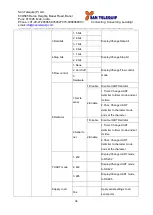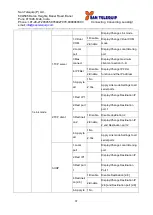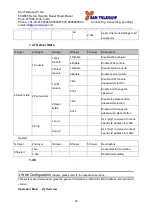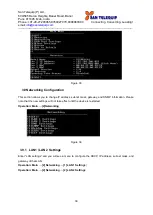
San Telequip (P) Ltd.,
504/505 Deron Heights, Baner Road, Baner
Pune 411045, Mah, India
Phone: +91-20-27293455,9764027070,8390069393 Connecting. Converting. Leading!
email:
---------------------------------------------------------------------------------------------------------------------------------------
49
you will find the following options.
Mode
, there are 3 different communication modes here:
RAW
, there is no protocol on this mode, meaning the data is passed transparently.
Virtual COM
, the Virtual COM protocol is enabled on the device to communicate with
a virtualized port from the client. It is possible to create a Virtual COM port on
Windows/Linux in order to communicate with the device as a Client.
Reverse Telnet
, used to connect the device and another serial device (usually a
Terminal Server) with a Telnet program. Telnet programs in Windows / Linux usually
require special handshaking to get the outputs and formatting show properly. The
SC10E16A1 Series will interact with those special commands (CR/LF commands)
once Reverse Telnet is enabled.
Enter the Local Port, this option specifies the port number that the server should listen to; it is
used by the client to connect to the server. Default local port is 4660.
Go to
for more information on this setting. For serial settings, go to
Sec.3.4.1
. For Advanced settings, go to
Sec.3.4.2
Scroll to the bottom of the page and click on “
Save Configuration
” button to save the changes.
Other important variables to consider are:
IP Filter
, enables the Source IP option below to block an IP address from accessing the COM
port.
Source IP
, specifies the device’s Source IP which will be transmitting data to our Server. In other
words, our Server will only allow data from this IP to flow (hence its own name implies Source IP);
only one source is allowed.
Maximum Connection
, the number of devices/clients (max. of 4 clients), to be served is set in
this section.
Response Behavior
, in which we will have as options:
Request & Response Mode
, it determines how the device will proceed when it receives
requests from connected hosts. Under this mode, the port will hold requests from all other
connected hosts until the serial device replies or the Response Interval timeout takes into
effect to discard it; however, unrequested data sent from the serial device would be forwarded
to all connected hosts.
Reply to requester only
, the port will reply to the connected host who requested the
data only.
Reply to all
, a reply is sent to all connected hosts.
Transparent mode
, the port will forward requests from all connected hosts to the serial
device immediately and reply to all connected hosts once it receives data from the serial
device.






























